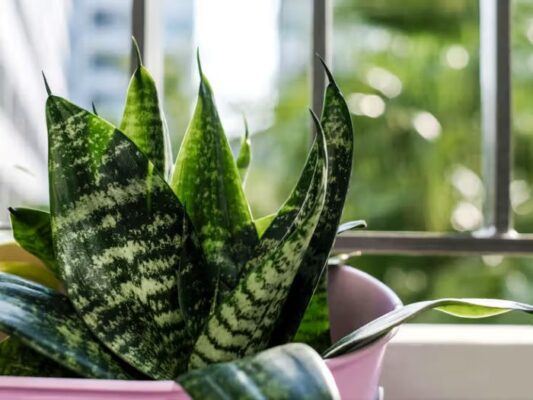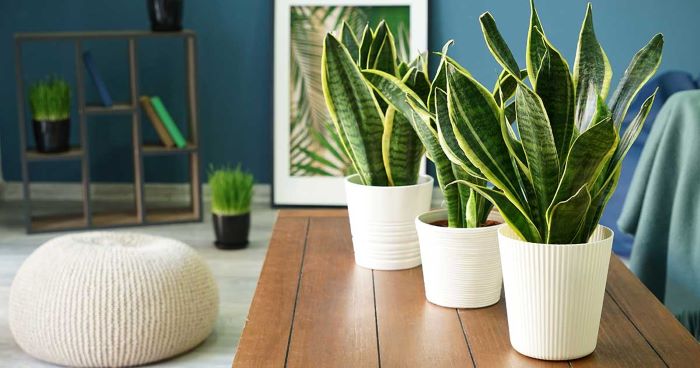Snake plants, also known as sansevieria or mother-in-law’s tongue, are popular and easy to grow houseplants known for their upright sword-shaped leaves and architectural shape. Native to tropical West Africa, snake plants are tolerant of a wide range of growing conditions which makes them excellent plants for beginners and busy indoor gardeners. In this article we talk about Snake Plant Essentials – How to Grow and Care for Sansevieria Indoors.
In this comprehensive guide, you’ll learn everything you need to successfully grow snake plants indoors including how to choose the best snake plant varieties, potting and soil recommendations, watering techniques, proper light conditions, tips on fertilization, how to propagate your snake plant, common pests and diseases to watch for, and more snake plant care essentials. Follow these simple tips and you’ll have healthy and thriving snake plants for years to come.
Table of Contents
Choosing a Snake Plant Variety

With over 70 species and varieties to choose from, there are many different snake plant types to grow. Some popular varieties include:
- Sansevieria trifasciata – Also called mother-in-law’s tongue. Features dark green upright leaves with light gray-green horizontal bands. Grows up to 4 feet tall.
- Sansevieria cylindrica – Cylindrical spear-like leaves grow in a rosette shape. Slow growing to about 3 feet tall.
- Sansevieria zeylanica – Dark green leaves with a distinctive concave shape. Grows to about 2 feet.
- Sansevieria masoniana – Known as whale fin sansevieria due to wide paddle-shaped leaves. Grows to about 4 feet.
- Sansevieria parva – A compact variety growing to about 1 foot tall with stiff dark green leaves. Great for tabletops and small spaces.
When choosing your snake plant variety, consider the mature size and growth habit as some grow quite large like sansevieria trifasciata while others stay small like sansevieria parva.
Potting Snake Plants
Snake plants do best when slightly rootbound so choose containers that are not much larger than the root ball. Make sure pots have drainage holes to prevent soggy soil. Terra cotta pots work well as they allow air flow to the roots.
Use a well-draining potting mix for cacti and succulents with ingredients like peat moss, bark, perlite, vermiculite or sand. Or create your own mix using equal parts potting soil, perlite or building sand, and peat moss or compost. Snake plants are sensitive to overly rich soil so avoid mixes with water-retentive amendments like coir or compost which can lead to rotting.
Watering Your Snake Plant
Snake plants are extremely drought tolerant so consistent watering is not necessary. Only water when the top few inches of soil become dry, about every 2-3 weeks on average. The less you water, the better for snake plants.
When you do water, thoroughly soak the soil until water drains from the drainage holes at the bottom of the pot. This encourages deeper root growth leading to healthier plants. Let excess water drain completely before returning the pot to its dish or cache pot if using one.
Avoid watering on a schedule as it is easy to overwater snake plants. Only water when the soil is partly dry. Signs your snake plant needs water include drooping or curling leaves and soil that appears dry and lighter in color.
Light Requirements
In their native habitat, snake plants grow in bright shade receiving filtered light so they are well adapted to a variety of indoor lighting conditions including artificial light. Place snake plants in a north, east or west facing window where they will receive consistent bright indirect light. Direct hot sunlight from a south facing window can scorch their leaves so provide sheer curtains to diffuse the light.
Snake plants also grow well in offices and interior rooms lit with fluorescent or LED grow lights. Rotate your snake plant periodically so all sides receive equal light exposure. Variegated varieties may lose their coloration in low light. Signs of insufficient light include elongated sparse growth and leaves that flop over.
Fertilizing Your Snake Plants
While snake plants grow well in poor soil without fertilizer, you can fertilize every 2-3 months during spring and summer using a balanced houseplant fertilizer diluted to half strength. This encourages faster growth. Stop fertilizing in fall and winter when growth naturally slows.
If repotting into fresh potting mix, no additional fertilizer is needed for the first 6 months as the new soil contains enough nutrients. Avoid overfertilizing which can cause floppy growth and salt accumulation. Flushing the soil every few months prevents fertilizer buildup.
Snake Plant Propagation
One of the best parts of growing snake plants is how easily they propagate from divisions, cuttings and offsets. This allows you to expand your collection with new plants for free.
Division – Carefully divide rootbound plants into smaller sections, ensuring each division has some roots and leaves attached. Allow divisions to dry briefly before repotting.
Stem cuttings – Use a clean knife or shears to cut a leaf with about 2 inches of stem. Allow the cut end to dry and callous before inserting into moist potting mix. New roots and shoots will eventually emerge.
Offsets – Mature snake plants produce pups or plantlets around the base which can be gently removed and repotted once they are a few inches tall. Sever the offset from the parent plant with a clean cut.
Caring for snake plant pups is the same as adult plants. Pot them in a small container using well-draining cactus mix until the new plant is established. Then repot into a larger container.
Pests and Diseases
Snake plants are not prone to many pest or disease issues, especially when provided with suitable growing conditions. However, watch for the following potential problems:
Insect pests like mealybugs, scale and spider mites. Treat with horticultural oil or insecticidal soap spray.
Root rot from overwatering or dense soil retaining moisture. Allow soil to fully dry between waterings.
Soft brown leaf tips caused by low humidity or irregular watering. Increase humidity or improve watering consistency.
Yellow leaves signify overwatering or excessive fertilizer. Flush soil to remove salts and allow plant to dry out.
Snake plants are sensitive to chemicals so avoid using pesticides if possible. Remove any diseased or pest-infested parts immediately to prevent spreading.
When to Repot Snake Plants
Repot snake plants every 2-3 years in spring using fresh potting mix, or whenever the roots fill the container. Going up one pot size allows room for additional root growth. Handling and repotting should be done gently to avoid damaging the roots or foliage. Don’t repot a stressed plant – wait until it is actively growing.
FAQ Snake Plant Care
How do I revive a dying snake plant?
If your snake plant looks poorly, the most common cause is overwatering. Check for root rot and stop watering. Allow the soil to fully dry out before watering again less frequently. Trim any mushy roots or leaves, repot in dry soil, provide brighter light, and reduce water.
Should I mist my snake plant?
No, misting is not helpful or recommended. Snake plants prefer dry air and moist soil. Misting increases humidity and moisture on the leaves which can lead to fungal leaf spot diseases. Instead, rely only on thorough soil watering.
Where should I place my snake plant?
Snake plants thrive in bright indirect light from an east, west or north window. South facing locations work if sheer curtains are used to filter intense direct sun which can scorch leaves. They also tolerate low artificial light. Avoid dark corners or rooms with no windows.
Do snake plants need to be in small pots?
Yes, snake plants prefer being slightly rootbound in pots that are not much larger than their root balls. Choose containers only one or two inches wider than the roots or plant. This keeps them happiest in an enclosed and secure environment. Overpotting into a too large container can cause stress.
Should I cut back tall snake plants?
If a snake plant stalk grows too large and tall becoming top heavy and falling over, you can trim it back by cutting the main stalk with sterilized pruners. However this is not necessary for health, and trimming will not make the plant bushier or fuller which is a common misconception.
Conclusion
With their upright spear-like leaves and resilience to varied growing situations, snake plants are the perfect low maintenance houseplant. Follow this indoor snake plant care guide for selecting the best snake plant types, watering properly, providing adequate light, troubleshooting problems, propagation through division, and more useful tips for keeping your sansevieria thriving for years of enjoyment. I sincerely hope you find this “Snake Plant Essentials – How to Grow and Care for Sansevieria Indoors” article helpful.
If you enjoyed this article, you might also like this one: Are Snake Plants Toxic to Cats?

